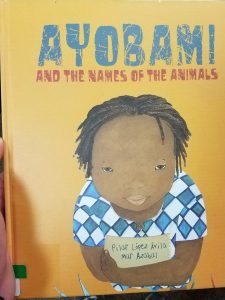
Title: Ayobami and the names of animals
Author: Pilar López Ávila
Illustrator: Mar Azabal
Publisher and Year: Shanghai Chenxi Printing CO. 2018
Number of pages: 30
Tags/Themes: Animals, Culture, Fiction, K-5, Evan White
Genre: Africa; Animals; Education; children’s picture book
Descriptive Annotation: Ayobami and the names of the animals is about a little African girl going back to school after a war. Her father shows her a path to get to school, but she gets confused and lost. She then asks for help from the animals in the jungle on how to get to school. They only help her if she promises to write their name on a piece of paper and give it to them. When she gets to school, she learns how to read a write, and she give a piece of paper with the animal’s name as she goes back home. There is no vocab background knowledge to know, but the only back ground the students may need to know is why Ayobami is allowed to go back to school. It may be helpful to explain how having a war takes away students’ opportunity for education.
Classroom Application: This text can be used to reinforce current events or recent events. This book shows how excited Ayobami is about going back to school because she want able to because of the war. It is never stated what war occurred, but I think this book could be an introduction and talking about wars across the globe and the effect on students and their families. I think I would introduce this book by having the kids display how they get to school. Do they walk, drive, take a bus? Who do they encounter on their way to school? This will get them in the mindset to understand how Ayobami gets to school.
Linguistic and Cultural Diversity Analysis: This book represents a group of children in Africa who can’t go to school every day. This generates conversations about what other places in the world is like, the difficulties people face but also how they have a goal to learn to read and write. On each page, there are letters art of the scenery, emphasizing the need to learn letters. “When the war finally came to an end, the teacher went from house to house, telling everyone that the children could go back to school the next day. The children ran out into the street, shouting with joy. They laughed and they hugged each other. They were very, very happy” (1). This quote shows how enthusiastic the students are for school and displays how much education means to them. What is most important is the picture associated with this quote. On the page, there are bullets on the ground, but cracked open. Coming out of the bullets are letters and painted flowers, showing a new age of hope for the students, along with the students dancing. “Ayobami’s father understood that she had learned to read and write at school. He understood that she had made the animals dream about the sound of their names. Clutching another piece of paper and another little stub of a pencil, the little girl set off to school again, along, the path that lead to the place where hope is born” (30). This quote shows how proud Ayobami’s father is of her. He expects greatness from and knows the value of learning reading and writing. Ayobami also sparked dreams in animals too, which can lead to her being an influence to others on the future. In the photo, Ayobami is dancing under a cloud that is raining letters. She has immersed herself in language and is so happy about it.
